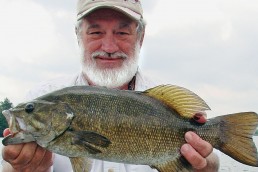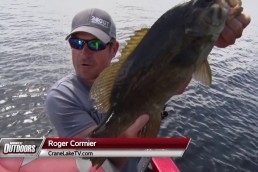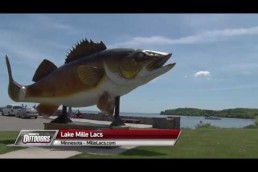A Guide’s Hard-won Early Smallmouth Secrets
SHARE THIS POST
The Northwoods offers endless opportunities for catching smallmouth bass. Much of my time is spent fishing on the Menominee River, which forms the border between Wisconsin and Michigan’s Upper Peninsula. However, I do spend considerable time fishing one of the countless clear-water, natural lakes. It’s nice to have so much water available that you don’t know where to fish first.
The early pre-spawn bite on natural lakes can be tough. But when the water warms to 45 degrees the bite can be phenomenal, if anglers follow a few guidelines. Following ice-out, locating and catching smallmouths can be difficult, as the deeper the lake is the slower it warms, making a longer holding period for smallmouths in their wintering areas. These are typically deep rock humps, the deep edges of points, deep wood and fish cribs. These deep smallmouths can be hard to locate even with electronics since they hold very tight to the cover. And even when you do locate them, they can be difficult to catch.
I’ve found the most aggressive smallmouths to be those relating to the fish cribs. This cover is common on many northern lakes and is usually put into waters with limited or no “natural” structure. Most cribs have been permanent fixtures in lakes for years, and the longer they’ve been in these lakes the more inviting they are to smallmouths. As a fish crib ages, it begins to deteriorate and becomes more fertile, attracting a variety of organisms and the fish. The cribs are popular haunts for panfishermen, but bassers often pass them up, especially in spring.
Smallmouths winter on the deep edges of fish cribs, and, unlike natural structure, they tend to be more aggressive. The problem is that these fish won’t rise up in the water column to strike a bait until water temperatures rise well into the 40s. So, you will need your electronics to position your boat over these fish and vertically jig them with either a hair jig or a lead-head jig tipped with a minnow. I’ve experimented with drop-shot rigs and have caught a few smallmouths, but I always catch more fish with the jigs. Once the water warms up, drop-shot rigs can outfish the jigs. Before these smallmouths abandon the cribs and enter into the pre-spawn they’ll rise up into the water column to strike baits. At this time, both lipless crankbaits and suspending jerkbaits can be productive.
Barring a descending Canadian cold front in April, the fish will remain in close proximity of these staging areas and usually are easier to locate. The advantage to staging smallmouths on clear lakes is that they’ll stack up in larger schools here more than in stained water reservoirs. Pre-spawn smallmouths will also suspend more in clear-water lakes than stained water, making them easier to find. (When dealing with water temperatures on deeper, clear lakes, you don’t always get what you see. Water temperatures can warm very slowly and a locator might read 45 degrees on the surface but it’s much colder on the edge of the deep hole where smallmouths are holding. It’s still winter to this species and they have no reason to leave their deep-water sanctuary.)
Just as on a stained water reservoir, steep rock structure is a prime staging area. If you’re looking for the honey hole look, for a transition like rock/sand, rock/gravel or a rock/soft bottom area. After any weather change or slight drop in water temperatures, these transitions can be a magnet. The water temperatures surrounding the rock shoreline can be a few degrees cooler. It’s the transition in the water temperatures that attracts the smallmouths, not the physical transition.
Are you enjoying this post?
You can be among the first to get the latest info on where to go, what to use and how to use it!
Fishing clearer waters always dictates using caution and taking extra precaution during the pre-spawn with these bigger smallmouths and the many numbers of them below. If you move in too fast you’ll spook the big smallmouths, and, while you might catch a few, a school will scatter. I stop my outboard far short of the transition area. I don’t spook the larger smallmouths, plus it gives me a chance to fish the open water adjacent from that transition. Start fishing the open waters with either a lipless crankbait or a swimbait too. After I catch a few on either of these and the action slows, I’ll switch to a suspending jerkbait.
During the pre-spawn plan on using suspending jerkbaits, which holds true whether you’re fishing a 1,000-acre lake or any of the Great Lakes. For jerkbaits to be effective an angler needs to adapt his presentation to the mood of the smallmouths. Since fishing with suspending jerkbaits in the colder waters now requires concentration and persistence, this method and mindset is not for the overzealous angler. The average angler will typically work a jerkbait with a sharp tug, let the jerkbait suspend, and then after a few seconds follow up with another sharp tug. If the water temperatures are on the rise and smallmouths are aggressive this technique works. Cooler water temperatures and post-frontal conditions, typical during the pre-spawn, call for a very slow approach.
The most productive method is to deadstick a jerkbait. After you’ve cautiously positioned your boat, make a long cast to the general area of the transition. Next, crank the jerkbait down to its maximum depth with 10 to 15 turns of the reel handle. Then, stop reeling and let the jerkbait “deadstick” or sit absolutely motionless in a suspending mode. The trick is in deciding how long to let the jerkbait sit motionless. On average, I let the jerkbait suspend for at least two minutes. If I’m sure smallmouths are present I will let the jerkbait suspend for as long as five minutes. As the jerkbait is suspending motionless make sure there’s sufficient slack in your line to compensate for any boat movement, especially if there’s a chop. It’s important to watch the slack line for any movement, as even the slightest movement of the line in one direction or the other can mean a smallmouth has taken the jerkbait. If you do want to move the jerkbait a bit, do so by moving the rod tip and not the reel. You don’t want to jerk the bait but slowly rock it.
Suspending jerkbaits are great for catching giant pre-spawn smallmouths, but are not good search baits. For locating fish, it’s tough to beat a lipless crankbait. These are very versatile and can be fished shallow or deep, fast or slow, and you can use a steady or stop-n-go retrieve. These baits have a fast sink rate too, so count down to the desired depth when fishing deeper waters. Also, make long casts parallel to deep, sloped banks, and remember to keep a lipless crankbait in the strike zone as long as possible.
Many northern lakes have quality smallmouths with trophy potential. Spring is prime time to do some exploring now.
MWO
SHARE THIS POST
Did you enjoy this post?
You can be among the first to get the latest info on where to go, what to use and how to use it!
Mike Mladenik
Mike Mladenik has been guiding for more than 30 years in Northern Wisconsin. Recognized as one of the top smallmouth bass experts in North America, he has boated 4,000+ smallmouth over 5 pounds and a few hundred over 6 pounds. Mike has authored 10 fishing books and gives seminars at sports shows across the Midwest. For more info: bigsmallmouthbass.com or 715-854-2055.



